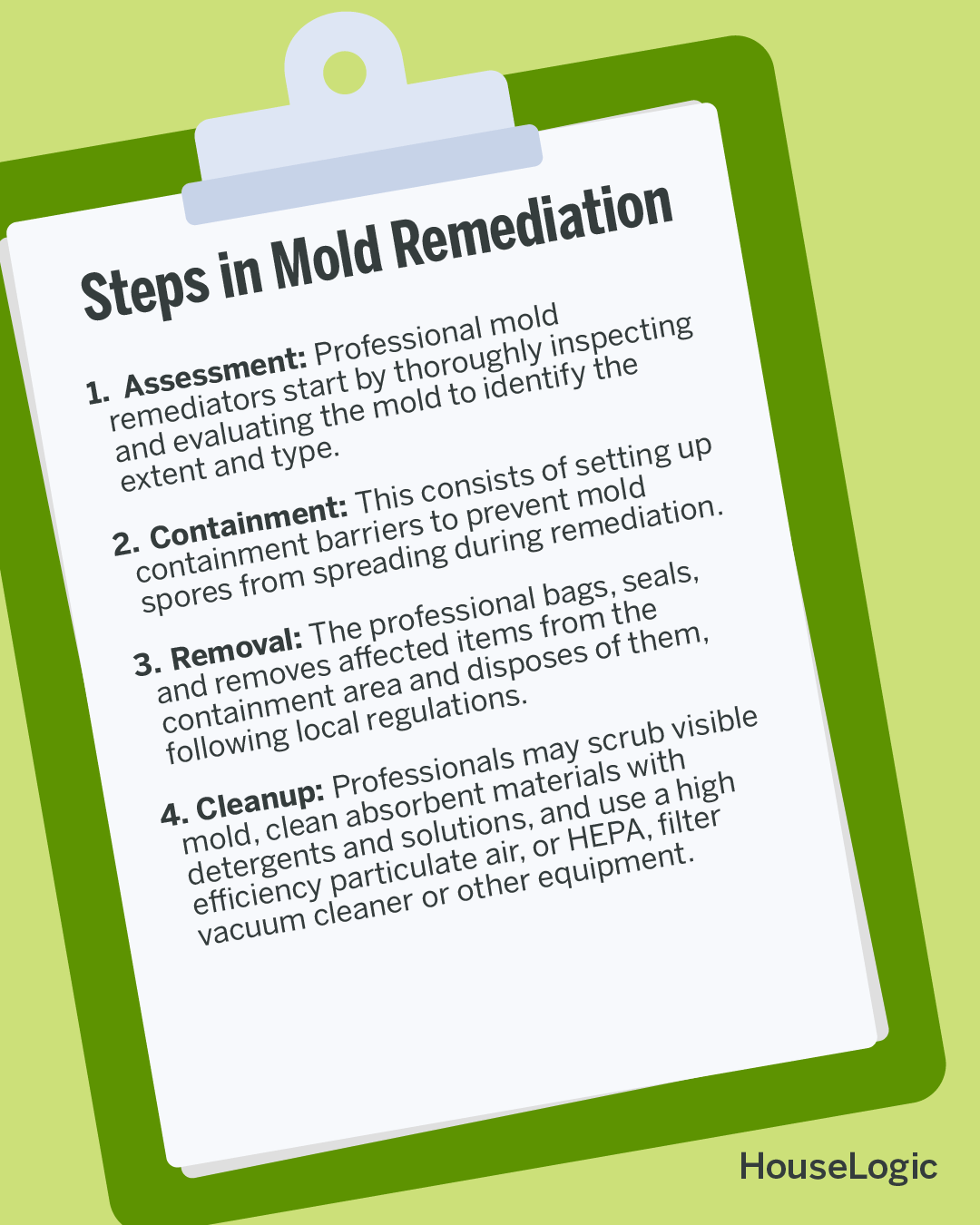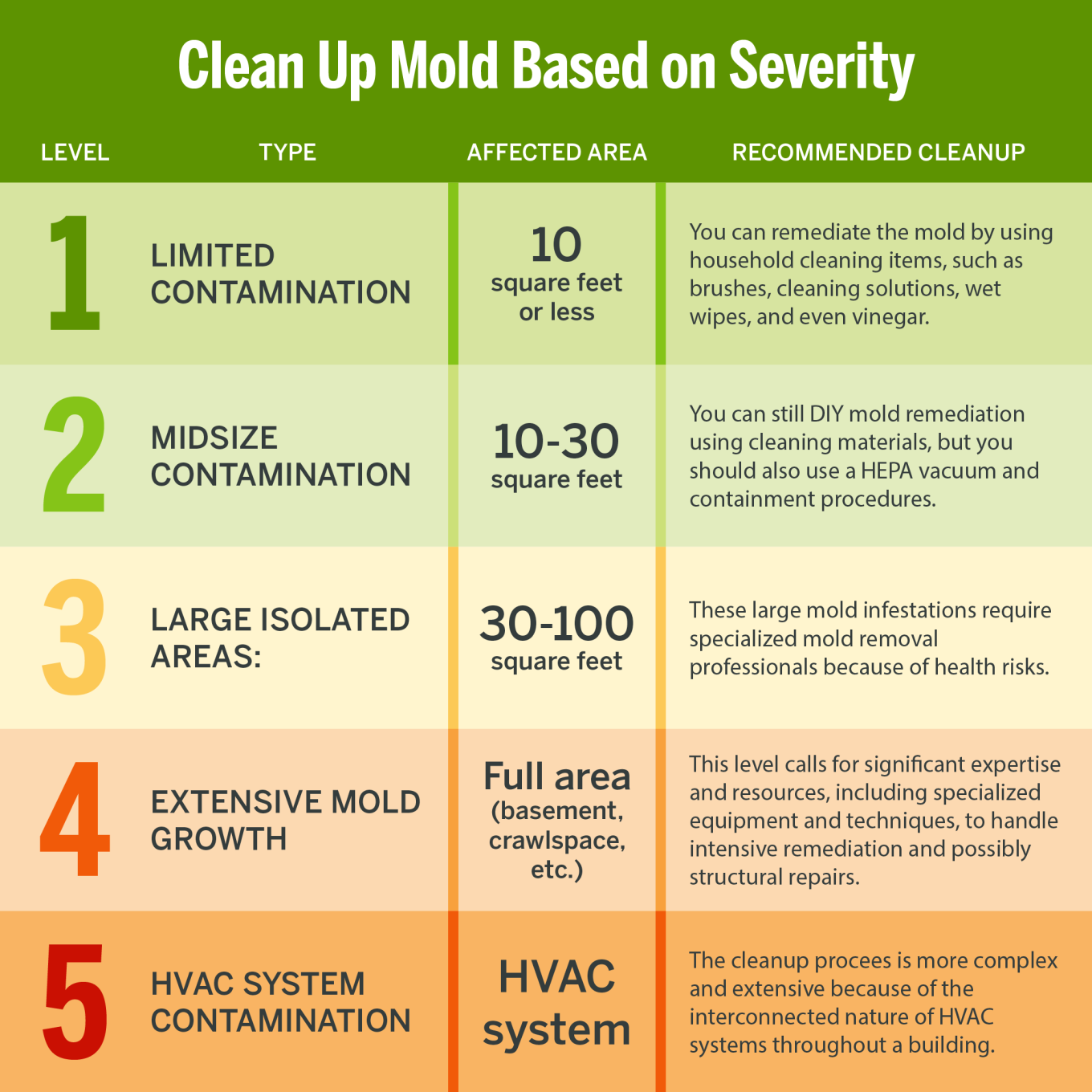Some homeowners may not know exactly what mold is or what to do about it. But they do know they don’t want it in their house. Here are somee basics: Mold is a naturally occurring fungus that can grow in homes when tiny airborne spores touch down on wet surfaces. Those wet surfaces can stem from leaks, poor ventilation, or water damage from hurricanes or floods. The mold often takes root in basements, but it can materialize in bathrooms, kitchens, laundry rooms, crawlspaces, and attics; under flooring and on windowsills; and in vents, dehumidifiers, air conditioners, and even plants. This range of locations and severity levels can bring mold professionals and mold removal costs into the picture.
If you see suspicious areas, find out the severity of the problem in your house and promptly hire a professional to evaluate those area. Your goal is to prevent the mold from spreading and causing illness to your household or damaging your home's structure. The more you know about professional mold removal and mold removal costs, the more quickly you can act.
Understanding Mold Remediation Costs

Mold remediation involves these four steps, according to John Parks, co-owner and chief operating officer of Advanced Insulation System in San Diego.
- Assessment: Professional mold remediators start by thoroughly inspecting and evaluating the mold to identify the extent and type.
- Containment: This consists of setting up containment barriers to prevent mold spores from spreading during remediation.
- Removal: The professional bags, seals, and removes affected items from the containment area and disposes of them, following local regulations. They remove the materials slowly to avoid spreading mold spores.
- Cleanup: This involves cleaning impacted areas with cleaning agents and specialized equipment. Professionals may scrub visible mold, clean absorbent materials with detergents and solutions, and use a high efficiency particulate air, or HEPA, filter vacuum cleaner or other equipment.
These steps underscore that mold remediation is beyond most homeowners’ capabilities. But before you hire a pro, you should investigate mold remediation costs. They average $2,361, but range from $373 to $7,000, according to 2024 data from Angi.
If you’re looking for mold removal costs on a square footage basis, the range is about $2.50 per square foot to $25 per square foot, including materials and labor, according to “Forbes.” Costs can vary if the mold removal technician uses containment or needs to remove drywall or other affected items that can’t be repaired.
What Factors Influence the Cost of Mold Remediation?
Many factors affect mold removal cost, says Robert Weitz, principal and founder of RTK Environmental Group in Stamford, Conn. They include:
- Labor time to perform the work
- The number and types of samples taken
- The amount of debris generated
- Access granted by the property owner
- The amount and location of visible mold
- The amount of cross-contamination in other rooms or areas
Other factors include regional variations and the method used. “Costs can vary significantly by region due to differences in labor rates, local regulations, and the prevalence of mold issues,” reports Parks. Mold remediation in a high-cost-of-living area like California or New York might be more expensive than in regions with lower living costs.”
The required method will also impact the mold removal cost, Parks says. Certain methods require extra materials — among them, HEPA vacuums, air scrubbers, and protective gear.
Extent and Severity of Contamination
The extent and severity of the mold contamination also factor into mold removal costs. “Larger or more severe infestations require more extensive work, increasing costs,” Parks says.
“Bathrooms will be more expensive to remediate and restore than a living room wall,” says Bethany Uribe, mitigation division supervisor with ASAP Restoration LLC in Tempe, Ariz. “There is likely a vanity or toilet that will need to be removed or replaced and possibly tiles or a shower pan that will be affected and sprayed and antimicrobial [applied], and then dried.”
PK Safety, based in Alameda, Calif., groups mold infestation into these five levels:

Level 1 – Limited contamination: The affected areas are small, typically 10 square feet or less, with mold spores on ceilings, tile, wall panels, and baseboards. You can remediate the mold by using household cleaning items, such as brushes, cleaning solutions, wet wipes, and even vinegar.
Level 2 – Midsize contamination: Midsize areas are around 10 square feet to 30 square feet and with an entire wallboard usually contaminated. You can still DIY mold remediation using cleaning materials, but you should also use a HEPA vacuum and containment procedures.
Level 3 – Large isolated areas: Mold growth appears in an area that's 30 square feet to 100 square feet on several large surfaces. These large mold infestations pose significant health risks and require specialized mold removal professionals.
Level 4 – Extensive mold growth: Mold contamination is widespread, often found in basements and crawlspaces. It requires intensive remediation procedures and possibly structural repairs. This level calls for significant expertise and resources, including specialized equipment and techniques to contain and remove mold spores.
Level 5 – HVAC system contamination: HVAC systems can become breeding grounds for mold because of the presence of moisture, organic materials, and mold-friendly conditions in ductwork or on the system’s surfaces. This level demands a more complex and extensive cleanup process because of the interconnected nature of HVAC systems throughout a building.
Accessibility of Affected Areas
Affected areas in walls, under floors, or in other hard-to-reach places drive up mold remediation costs. Where the mold is located in the home also makes a difference, Angi reports.
| Location | Cost |
| Attic | $1,000 to $4,000 |
| Basement | $500 to $3,000 |
| Bathroom | $500 to $1,000 |
| Crawlspace | $500 to $2,000 |
| Drywall | $1,000 to $20,000 |
| HVAC | $3,000 to $10,000 |
| Entire House | $10,000 to $30,000 |
In addition to common location, contamination can also occur in some unexpected places, such as in front-loading washers and air conditioners.
Type of Mold
The type of mold can also affect the duration and cost of work, Parks says. Some types, such as black mold, can be more hazardous and require specialized handling.
Here are types of mold with average removal costs, including labor and materials, according to Fixr:
| Type of Mold | Cost |
| Alternaria | $700 to $6,000 |
| Aspergillus | $700 to $6,000 |
| Black mold (Stachybotrys chartarum) | $800 to $7,000 |
| Chaetomium | $600 to $5,000 |
| Cladosporium | $700 to $6,000 |
| Fusarium | $800 to $8,000 |
| Green mold (Penicillium digitatum) | $700 to $6,000 |
| Serpula lacrymans | $800 to $7,000 |
| Ulocladium | $600 to $6,000 |
| White mold | $700 to $6,000 |
Price of Mold Removal by Location
Estimated professional mold remediation costs vary by location. On the West Coast, costs can range from $3,000 to $100,000; on the East Coast, $3,000 to $90,000; and in the Midwest and South, $2,500 to $80,000 or $85,000, says Parks.
Weitz says he believes the cost of remediation in the Tri-State region around New York City ranges from $2,000 to $100,000, with the average being $10,000 to $20,000.
Mold Remediation Cost Comparison: DIY or Hire a Professional?
While homeowners may be able to DIY minor mold issues, they should usually hire professionals. That's because the stakes are so high. Health experts haven’t identified acceptable mold exposure levels for humans, and some individuals are more likely to react to mold exposure.
Whether you hire a professional can depend on whether your home’s structure is involved. "When sheetrock or wallboard consisting of paper over gypsum becomes wet, mold will attach to the paper and grow," says Weitz. “When the mold works its way inward, and is untreated, the degradation will develop into large-scale rot.”
Despite mold risks, homeowners may hesitate to hire a professional because of the expense and time involved in professional mold remediation. Professional time frames range from a few days to a few months based on the size and the scope of damage, says Weitz. Parks estimates most pros complete mold remediation projects in three to seven days on average.
Before deciding to DIY, consider the cost of mistakes. “We’ve had many clients who attempted to do their own demolition after discovering mold, only to realize the work is extensive and beyond their technical grasp,” Uribe says. The result can be higher costs because the “property owners spread contamination and caused additional secondary damages.”
Weitz offers this advicee to decide between DIY and expert help:
- DIY: Attempt to treat only very small areas of visible mold.
- Hire a pro: Call a professional immediately to develop a removal plan if you spot visible mold on larger areas, particularly on cellulose materials like wallboard or wood trim. What you see on the surface often represents only half the actual mold growth. The rest is hidden on the backside.
Prevention is the best course to avoid professional mold removal costs. You can reduce the chance of mold contamination by keeping indoor relative humidity between 30% and 50%, according to the University of Georgia Extension’s “Mold, the Uninvited Guest” series. In addition, be consistent with maintenance. For example, repair leaky pipes and faucets, turn on exhaust fans when cooking or bathing, clean gutters, and keep water drains away from your home.
FAQs Mold Abatement Costs
Can Mold Be Successfully Removed from a House?
Even though it's impossible to get rid of all mold and mold spores indoors, they need moisture to grow. So, by controlling moisture indoors, homeowners can prevent or control indoor mold growth.
Successful professional removal depends on factors such as the surface area affected by mold, the extent of mold present, the amount of building material that needs replacing, the need for testing to ensure safety, and existing air quality, according to Angi.
How Long Does It Take to Remove Mold from a House?
Mold removal takes an average of one to three days for small to medium projects and up to seven days for large projects or severe mold growth, according to HomeGuide. Restoration may take longer if the project requires drywall or carpet replacement.
You may need to leave your house during mold remediation, depending on the location and amount of mold. If the growth is limited to one small area, technicians can usually contain and treat the affected area while your household stays in another part of the house. But for homes with large or severe mold growth, most experts recommend you leave your house during remediation.
What Causes Mold?
Mold spores continually drift through indoor air, says the EPA. They may begin growing when they land on a damp spot indoors. That's especially true where excessive moisture has accumulated, such as in bathrooms, basements, and damp corners. They may also flourish if the moisture remains undiscovered or isn’t addressed.
Inside sources that generate mold include water leaks from roofs, pipes, or windows. High humidity from poor ventilation, especially in bathrooms and kitchens, can also produce mold. Other sources are condensation, particularly in winter months, damp materials, increased moisture from showering and cooking, and location and climate.
